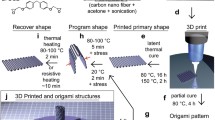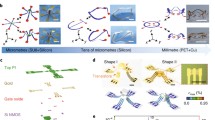Abstract
Development of miniaturized three-dimensional (3D) fliers with integrated functional components has important implications to a diverse range of engineering areas. Among the various active and passive miniaturized 3D fliers reported previously, a class of 3D electronic fliers inspired by wind-dispersed seeds show promising potentials, owing to the lightweight and noiseless features, aside from the stable rotational fall associated with a low falling velocity. While on-demand shape-morphing capabilities are essential for those 3D electronic fliers, the realization of such miniaturized systems remains very challenging, due to the lack of fast-response 3D actuators that can be seamlessly integrated with 3D electronic fliers. Here we develop a type of morphable 3D mesofliers with shape memory polymer (SMP)-based electrothermal actuators, capable of large degree of actuation deformations, with a fast response (e.g., ∼1 s). Integration of functional components, including sensors, controllers, and chip batteries, enables development of intelligent 3D mesoflier systems that can achieve the on-demand unfolding, triggered by the processing of real-time sensed information (e.g., acceleration and humidity data). Such intelligent electronic mesofliers are capable of both the low-air-drag rising and the low-velocity falling, and thereby, can be used to measure the humidity fields in a wide 3D space by simple hand throwing, according to our demonstrations. The developed electronic mesofliers can also be integrated with other types of physical/chemical sensors for uses in different application scenarios.

摘要
集成功能器件的三维(3D)微型飞行器在工程领域多个方面都具有重要意义. 在近期报道的各种主动和被动型三维微型飞行器中, 一类由风传种子启发的三维飞行器因其具备低速自旋稳定下落、 超轻、 静音等特点, 显示出巨大的应用潜力. 具备按需形状重构的能力对于这类三维飞行器至关重要, 然而由于缺乏可与三维飞行器无缝集成的快速响应驱动器, 制造这类智能微型飞行器系统仍然具有挑战. 在这项研究工作中, 我们开发了一种基于形状记忆聚合物(SMP)电热驱动器的可变形三维介观飞行器, 其能够实现较大驱动变形和快速响应(∼1 s). 通过集成传感器、控制器和微型锂电池等功能器件, 我们开发了一种智能三维介观飞行器系统. 该系统通过实时处理感知的信息(如加速度和湿度数据)以实现按需展开. 这种智能电子介观飞行器具备低阻上升和低速下降的能力, 本文演示了通过简单的投掷测量广阔空间的湿度场分布. 此外, 这种智能三维介观飞行器还可以集成其他类型的物理/化学传感器以适应不同的应用场景.
Similar content being viewed by others
References
Kim BH, Li K, Kim JT, et al. Three-dimensional electronic microfliers inspired by wind-dispersed seeds. Nature, 2021, 597: 503–510
Jin J, Wang Y, Jiang H, et al. Evaluation of microclimatic detection by a wireless sensor network in forest ecosystems. Sci Rep, 2018, 8: 16433
Ma KY, Chirarattananon P, Fuller SB, et al. Controlled flight of a biologically inspired, insect-scale robot. Science, 2013, 340: 603–607
Beyeler A, Zufferey J, Floreano D. 3D vision-based navigation for indoor microflyers. In: Proceedings 2007 IEEE International Conference on Robotics and Automation. Italy, 2007. 1336–1341
Rabault J, Fauli RA, Carlson A. Curving to fly: Synthetic adaptation unveils optimal flight performance of whirling fruits. Phys Rev Lett, 2019, 122: 024501
Ozaki T, Ohta N, Jimbo T, et al. A wireless radiofrequency-poweredi_sect-scale flapping-wing aerial vehicle. Nat Electron, 2021, 4: 845–852
Jafferis NT, Helbling EF, Karpelson M, et al. Untethered flight of an insect-sized flapping-wing microscale aerial vehicle. Nature, 2019, 570: 491–495
Li G, Chen X, Zhou F, et al. Self-powered soft robot in the Mariana trench. Nature, 2021, 591: 66–71
Xiong W, Zhu C, Guo D, et al. Bio-inspired, intelligent flexible sensing skin for multifunctional flying perception. Nano Energy, 2021, 90: 106550
Jeong JW, Yeo WH, Akhtar A, et al. Materials and optimized designs for human-machine interfaces via epidermal electronics. Adv Mater, 2013, 25: 6839–6846
Wang Y, Yang X, Chen Y, et al. A biorobotic adhesive disc for underwater hitchhiking inspired by the remora suckerfish. Sci Robot, 2017, 2: eaan8072
Dong W, Gu GY, Zhu X, et al. A high-performance flight control approach for quadrotors using a modified active disturbance rejection technique. Robot Auton Syst, 2016, 83: 177–187
Liu Y, He K, Chen G, et al. Nature-inspired structural materials for flexible electronic devices. Chem Rev, 2017, 117: 12893–12941
Li T, Li G, Liang Y, et al. Fast-moving soft electronic fish. Sci Adv, 2017, 3: e1602045
Augspurger CK. Morphology and dispersal potential of wind-dispersed diaspores of neotropical trees. Am J Bot, 1986, 73: 353–363
Greene DF, Johnson EA. Seed mass and dispersal capacity in wind-dispersed diaspores. Oikos, 1993, 67: 69–74
Nathan R. Long-distance dispersal of plants. Science, 2006, 313: 786–788
Kim BH, Liu F, Yu Y, et al. Mechanically guided post-assembly of 3D electronic systems. Adv Funct Mater, 2018, 28: 1803149
Xu S, Yan Z, Jang KI, et al. Assembly of micro/nanomaterials into complex, three-dimensional architectures by compressive buckling. Science, 2015, 347: 154–159
Zhang Y, Zhang F, Yan Z, et al. Printing, folding and assembly methods for forming 3D mesostructures in advanced materials. Nat Rev Mater, 2017, 2: 17019
Xue Z, Song H, Rogers JA, et al. Mechanically-guided structural designs in stretchable inorganic electronics. Adv Mater, 2020, 32: 1902254
Chung HU, Kim BH, Lee JY, et al. Binodal, wireless epidermal electronic systems with in-sensor analytics for neonatal intensive care. Science, 2019, 363: eaau0780
Huang YA, Wu H, Xiao L, et al. Assembly and applications of 3D conformal electronics on curvilinear surfaces. Mater Horiz, 2019, 6: 642–683
Wu H, Huang YA, Xu F, et al. Energy harvesters for wearable and stretchable electronics: From flexibility to stretchability. Adv Mater, 2016, 28: 9881–9919
Kim DH, Ahn JH, Choi WM, et al. Stretchable and foldable silicon integrated circuits. Science, 2008, 320: 507–511
Kim DH, Xiao J, Song J, et al. Stretchable, curvilinear electronics based on inorganic materials. Adv Mater, 2010, 22: 2108–2124
Jang KI, Chung HU, Xu S, et al. Soft network composite materials with deterministic and bio-inspired designs. Nat Commun, 2015, 6: 6566
Koo J, Kim SB, Choi YS, et al. Wirelessly controlled, bioresorbable drug delivery device with active valves that exploit electrochemically triggered crevice corrosion. Sci Adv, 2020, 6: eabb1093
Kim DH, Viventi J, Amsden JJ, et al. Dissolvable films of silk fibroin for ultrathin conformal bio-integrated electronics. Nat Mater, 2010, 9: 511–517
Viventi J, Kim DH, Vigeland L, et al. Flexible, foldable, actively multiplexed, high-density electrode array for mapping brain activity in vivo. Nat Neurosci, 2011, 14: 1599–1605
Li H, Chang T, Gai Y, et al. Human joint enabled flexible self-sustainable sweat sensors. Nano Energy, 2022, 92: 106786
Cheng X, Zhang F, Bo R, et al. An anti-fatigue design strategy for 3D ribbon-shaped flexible electronics. Adv Mater, 2021, 33: 2102684
Cheng X, Zhang Y. Micro/nanoscale 3D assembly by rolling, folding, curving, and buckling approaches. Adv Mater, 2019, 31: 1901895
Guo X, Xue Z, Zhang Y. Manufacturing of 3D multifunctional microelectronic devices: Challenges and opportunities. NPG Asia Mater, 2019, 11: 29
Luo G, Fu H, Cheng X, et al. Mechanics of bistable cross-shaped structures through loading-path controlled 3D assembly. J Mech Phys Solids, 2019, 129: 261–277
Zhao J, Zhang F, Guo X, et al. Torsional deformation dominated buckling of serpentine structures to form three-dimensional architectures with ultra-low rigidity. J Mech Phys Solids, 2021, 155: 104568
Liu J, Yan D, Zhang Y. Mechanics of unusual soft network materials with rotatable structural nodes. J Mech Phys Solids, 2021, 146: 104210
Ma Q, Cheng H, Jang KI, et al. A nonlinear mechanics model of bio-inspired hierarchical lattice materials consisting of horseshoe microstructures. J Mech Phys Solids, 2016, 90: 179–202
Yan D, Chang J, Zhang H, et al. Soft three-dimensional network materials with rational bio-mimetic designs. Nat Commun, 2020, 11: 1180
Song H, Luo G, Ji Z, et al. Highly-integrated, miniaturized, stretchable electronic systems based on stacked multilayer network materials. Sci Adv, 2022, 8: eabm3785
Bai K, Cheng X, Xue Z, et al. Geometrically reconfigurable 3D mesostructures and electromagnetic devices through a rational bottom-up design strategy. Sci Adv, 2020, 6: eabb7417
Pang W, Cheng X, Zhao H, et al. Electro-mechanically controlled assembly of reconfigurable 3D mesostructures and electronic devices based on dielectric elastomer platforms. Natl Sci Rev, 2020, 7: 342–354
Fu H, Nan K, Bai W, et al. Morphable 3D mesostructures and microelectronic devices by multistable buckling mechanics. Nat Mater, 2018, 17: 268–276
Zhu B, Wang H, Liu Y, et al. Skin-inspired haptic memory arrays with an electrically reconfigurable architecture. Adv Mater, 2016, 28: 1559–1566
Davidson EC, Kotikian A, Li S, et al. 3D printable and reconfigurable liquid crystal elastomers with light-induced shape memory via dynamic bond exchange. Adv Mater, 2020, 32: 1905682
Zhang F, Li S, Shen Z, et al. Rapidly deployable and morphable 3D mesostructures with applications in multimodal biomedical devices. Proc Natl Acad Sci USA, 2021, 118: e2026414118
Yang H, Leow WR, Chen X. Thermal-responsive polymers for enhancing safety of electrochemical storage devices. Adv Mater, 2018, 30: 1704347
Huang Y, Zheng N, Cheng Z, et al. Direct laser writing-based programmable transfer printing via bioinspired shape memory reversible adhesive. ACS Appl Mater Interfaces, 2016, 8: 35628–35633
Wang X, Guo X, Ye J, et al. Freestanding 3D mesostructures, functional devices, and shape-programmable systems based on mechanically induced assembly with shape memory polymers. Adv Mater, 2019, 31: 1805615
Jin B, Song H, Jiang R, et al. Programming a crystalline shape memory polymer network with thermo- and photo-reversible bonds toward a single-component soft robot. Sci Adv, 2018, 4: eaao3865
Zhao Q, Zou W, Luo Y, et al. Shape memory polymer network with thermally distinct elasticity and plasticity. Sci Adv, 2016, 2: e1501297
Kim BS, Kim MK, Cho Y, et al. Electrothermal soft manipulator enabling safe transport and handling of thin cell/tissue sheets and bioelectronic devices. Sci Adv, 2020, 6: eabc5630
Zheng N, Huang Y, Zhao Q, et al. Shape memory polymers for flexible electronics. Sci Sin-Phys Mech Astron, 2016, 46: 044602
Wang Y, Yu K, Qi HJ, et al. Temperature dependent evolution of wrinkled single-crystal silicon ribbons on shape memory polymers. Soft Matter, 2017, 13: 7625–7632
Acknowledgements
Zhang Y acknowledges support from the National Natural Science Foundation of China (12050004 and 11921002), the Tsinghua National Laboratory for Information Science and Technology, and a grant from the Institute for Guo Qiang, Tsinghua University (2019GQG1012). Song H acknowledges support from the National Natural Science Foundation of China (11902178), the Natural Science Foundation of Beijing Municipality (3204043), and China Postdoctoral Science Foundation (2019M650648). Xue Z acknowledges support from the National Natural Science Foundation of China (61904095).
Author information
Authors and Affiliations
Contributions
Author contributions Zhang Y, Song H, and Xue Z conceived the idea; Zhao J and Ji Z performed numerical simulations; Song H, Ji Z, Xu S, Pang W, Hu X, Zhang F, Jin T, Shuai Y, Lan Y, Cheng D, Man W, and Bo R designed and performed the fabrication and measurements of electrothermal actuators and mesoflier structures; Song H, Ji Z, and Xue Z performed the fabrication and measurements of electronic mesoflier systems; Zhang Y, Xue Z, Zhao J, Song H, and Ji Z wrote the manuscript. All authors discussed and reviewed the final version.
Corresponding authors
Ethics declarations
Conflict of interest The authors declare that they have no conflict of interest.
Additional information
Supplementary information Supporting data are available in the online version of the paper.
Ziyao Ji is a PhD student under the supervision of Prof. Yihui Zhang at Tsinghua University. His research interest focuses on mechanically-guided 3D assembly.
Jianzhong Zhao received his PhD degree from Shanghai University in 2021. He is now a postdoctoral fellow at Tsinghua University. His research interest focuses on mechanically-guided 3D assembly and mechanics of flexible electronics.
Honglie Song received his PhD degree from Jilin University in 2017. He is now a postdoctoral fellow at Tsinghua University. His research interest focuses on the flexible and stretchable electronics, mechanically-guided 3D assembly, and bionic sensing/perception.
Zhaoguo Xue is an associate professor at Beihang University. He received his PhD degree from Nanjing University in 2018, and worked as a postdoctoral fellow at Tsinghua University from 2018 to 2020. His research interest includes mechanically-guided 3D assembly, stretchable and flexible nanoelectronics, and semiconductor nanomaterials.
Yihui Zhang is a professor at Tsinghua University. He received his PhD degree from Tsinghua University in 2011, and worked as a postdoctoral fellow from 2011 to 2014, and as a research assistant professor from 2014 to 2015, both at Northwestern University. His research interests include mechanically-guided 3D assembly, unusual soft materials, and stretchable electronics.
Supplementary Material
Rights and permissions
About this article
Cite this article
Ji, Z., Zhao, J., Song, H. et al. Morphable three-dimensional electronic mesofliers capable of on-demand unfolding. Sci. China Mater. 65, 2309–2318 (2022). https://doi.org/10.1007/s40843-022-2007-8
Received:
Accepted:
Published:
Issue Date:
DOI: https://doi.org/10.1007/s40843-022-2007-8




